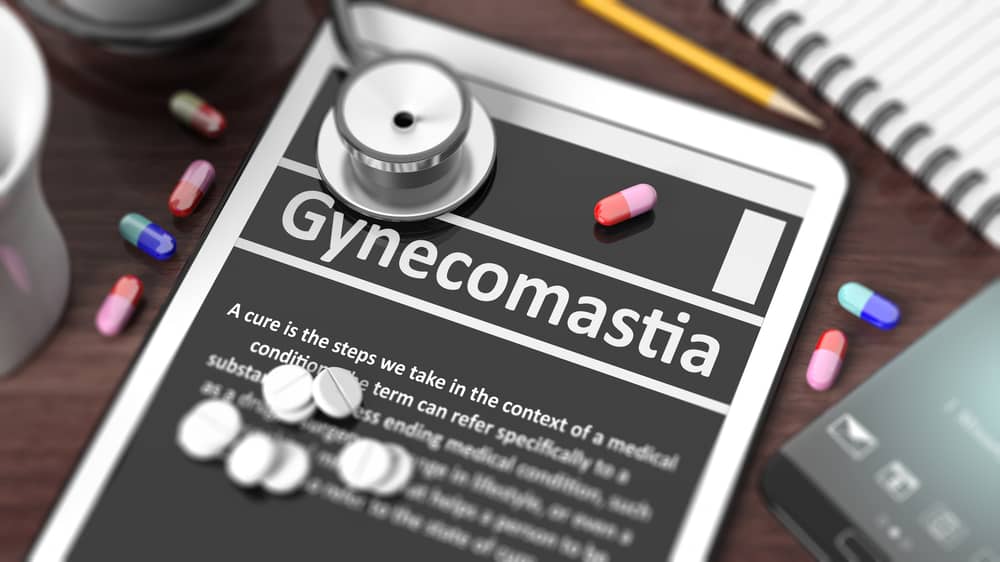Have you been feeling self-conscious about excess chest tissue and wondering if there’s a way to fix it without going under the knife? Gynecomastia, “man boobs”, or enlarged male breasts, is more common than many realize—and the good news is, not every case needs surgery to improve.
Thanks to modern advancements in aesthetic medicine, there are several ways to treat gynecomastia without surgery that can effectively target the root causes of gynecomastia, especially if it’s primarily due to excess fat. Let’s explore what options might be right for you and how to get the results you’re looking for.

Can True Gynecomastia Be Cured Without Surgery?
In many cases, yes—but it depends on the type. Gynecomastia comes in two main forms: glandular gynecomastia, which involves the growth of breast gland tissue, and fatty gynecomastia (also known as pseudogynecomastia), which is simply excess fat in the chest area. While the glandular type of gynecomastia often requires surgery to remove the dense glandular tissue, pseudogynecomastia can usually be treated with non-invasive methods like fat-reducing treatments, lifestyle changes, and hormone balancing therapies.
What are the Causes of Gynecomastia?
Gynecomastia doesn’t have a one-size-fits-all cause. It can result from natural hormone shifts, lifestyle habits, or underlying health conditions. Understanding what’s behind your case of gynecomastia is key to selecting the right treatment path—whether surgical or non-surgical. Below are the most common causes that contribute to this condition:
Hormonal Imbalances
The most frequent cause of gynecomastia is an imbalance between estrogen and testosterone levels. Men naturally produce both hormones, but when estrogen levels rise or testosterone drops, breast tissue can begin to develop. This is especially common during puberty, middle age, or older adulthood.
Certain Medications
A number of prescription drugs are linked to gynecomastia, including anti-androgens (used for prostate issues), anabolic steroids, anti-anxiety medications, antidepressants, and even some antibiotics. These substances can interfere with hormone regulation and stimulate breast tissue growth.
Substance Use
Alcohol, marijuana, and other recreational drugs like heroin or amphetamines have been associated with gynecomastia. These substances may affect hormone levels or liver function, both of which play a role in maintaining proper hormone balance.
Medical Conditions
Liver disease, kidney failure, thyroid disorders, and certain tumors (like testicular or adrenal) can disrupt hormone levels and lead to breast enlargement. In these cases, treating the underlying condition is a critical part of managing gynecomastia.
Obesity
Carrying excess body fat can increase estrogen production, especially in fat cells around the chest area. In obese individuals, this can result in pseudogynecomastia or worsen true gynecomastia by increasing both fat and glandular tissue.
Natural Life Stages
Gynecomastia is often seen during specific life stages, like infancy (due to maternal hormones), puberty (due to hormonal surges), and aging (as testosterone production declines). In many cases, it resolves on its own, but sometimes treatment is necessary if it persists.
Non-Surgical Treatments for Gynecomastia
If your gynecomastia is primarily caused by excess fat rather than glandular tissue, non-surgical treatments may offer noticeable improvement without the need for downtime or incisions. These non-surgical treatment options target fat cells and skin elasticity using modern, non-invasive technologies that can refine chest contours safely and gradually. Below are two of the most popular and effective non-surgical methods available today:
CoolSculpting (Cryolipolysis)
CoolSculpting uses controlled cooling to freeze and eliminate fat cells without damaging surrounding tissues. It’s FDA-cleared for fat reduction and commonly used to treat areas like the chest in men with pseudogynecomastia. Over several weeks, the body naturally flushes out the destroyed fat cells, leading to a more sculpted chest. The treatment is non-invasive, requires no anesthesia, and typically involves little to no downtime, making it a convenient option for men looking to reduce chest fat discreetly and effectively.
Ultrasound or Radiofrequency Therapy
These energy-based treatments work by heating the underlying layers of skin and fat to stimulate collagen production and promote fat cell breakdown. Ultrasound and radiofrequency devices can help tighten the skin and reduce mild to moderate fat deposits in the chest area. While results may take several sessions and are generally more subtle than surgical outcomes, they are effective for refining contours in men with pseudogynecomastia who prefer non-invasive solutions.
Are You Ready For A Consultation?
You are about to take the first steps towards improving your appearance and enhancing your self-image by learning about contemporary plastic surgery.
Other Ways to Reduce Excess Chest Fat
While non-surgical treatments like CoolSculpting and radiofrequency therapies can be effective, they aren’t the only paths to addressing excess chest fat. For many men, lifestyle changes or medical interventions aimed at addressing the underlying cause of fat accumulation can also produce meaningful results. The following options range from behavioral adjustments to medical therapies that may help reduce the appearance of a fuller chest without surgical intervention:
Weight Loss: Diet and Exercise
Improving your diet and increasing physical activity can significantly reduce excess fat in the chest area. While this won’t affect glandular tissue, it can help shrink fat cells contributing to pseudogynecomastia. A consistent routine of cardiovascular exercise and strength training—especially chest-focused movements—paired with a balanced, calorie-conscious diet may result in a leaner, more defined upper body. This approach not only improves appearance but also supports overall health and hormone balance, making it a foundational strategy for many men.
Testosterone Replacement Therapy
Low testosterone levels can contribute to the development of gynecomastia by disrupting the body’s natural hormone balance. In some cases, restoring testosterone to a healthy range through hormone replacement therapy (HRT) can reduce excess breast tissue, especially when combined with other supportive treatments. This option is typically recommended after blood tests confirm a hormonal deficiency. It’s important to consult a qualified medical provider to ensure proper dosing and monitoring, as testosterone therapy isn’t suitable or effective for all men.
Reducing Alcohol Intake or Drug Abuse
Substance use is a common yet often overlooked contributor to gynecomastia. Alcohol can disrupt liver function, which affects the body’s ability to metabolize hormones properly, potentially raising estrogen levels. Recreational drugs like marijuana, heroin, and anabolic steroids have also been linked to hormone imbalances that lead to breast tissue growth. Reducing or eliminating these substances not only helps restore hormonal balance but also improves overall health, which can indirectly support fat reduction and prevent further development of gynecomastia.
Treating Underlying Health Conditions
In some cases, gynecomastia is a symptom of an underlying medical issue such as liver disease, thyroid dysfunction, or hormonal disorders. Treating these root health problems can often reverse or improve breast tissue enlargement. For example, managing hyperthyroidism or optimizing liver function may restore hormonal balance naturally. This approach requires proper diagnosis through blood work and imaging, followed by targeted treatment. Addressing the medical condition behind the gynecomastia ensures a more sustainable and holistic resolution.
Some Off-Label Medications
Certain medications can cause or worsen gynecomastia, either by altering hormone levels or directly stimulating breast tissue growth. In some cases, physicians may prescribe off-label medications like tamoxifen or raloxifene—selective estrogen receptor modulators (SERMs)—to counteract excess estrogen. In other cases, switching from a medication known to contribute to gynecomastia (such as some heart, ulcer, blood pressure, or antidepressant drugs) to an alternative may reduce or reverse the condition. Always consult a healthcare provider before starting, stopping, or changing any medication, and discuss potential side effects and long-term implications.
Home Remedies
While home remedies are unlikely to fully reverse true gynecomastia, they can complement medical or professional treatments—especially for pseudogynecomastia. Common approaches include regular exercise (with an emphasis on cardio and chest-strengthening moves), a balanced diet rich in whole foods, and maintaining a healthy body weight to reduce fat accumulation. Some men find that reducing sodium intake helps minimize fluid retention, which can subtly improve chest contour. Herbal supplements are sometimes promoted for hormonal balance, but their effectiveness and safety are not well-studied; it’s best to review these with a medical professional before use.
When is Gynecomastia Surgery the Best Option?
While non-surgical approaches can significantly reduce chest fat in many men with gynecomastia, they may not be effective for true gynecomastia involving dense glandular tissue. In such cases, surgical removal is often the only way to achieve a firm, contoured, masculine chest. Surgery is also ideal for those who have not responded to lifestyle or medical treatments.
If you’re experiencing physical discomfort, persistent fullness despite trying non-surgical options, hormone treatments, or simply want more dramatic and permanent results, male breast reduction surgery might be the right next step.
Who Should Perform My Male Breast Reduction Surgery?
Choosing the right specialist for gynecomastia treatment is crucial to ensure the best outcome, especially when surgery becomes the most effective option. Look for a board-certified plastic surgeon with proven experience in male breast reduction and specialization in body contouring procedures. The surgeon should have a strong understanding of the anatomy and nuances of male chest tissue, offer before-and-after case studies, and use techniques that minimize scarring while ensuring natural, masculine results.
Schedule an Appointment with a Body Surgery Specialist
Dr. Casey Holmes at The Aesthetic Surgery Center in Naples, FL, is a Board Certified Plastic and Reconstructive Surgeon with advanced fellowship training in aesthetic surgery of the face, breast, and body. His expertise in male breast reduction allows him to deliver natural-looking results using the latest surgical and non-surgical methods. Call us at 239-420-8503 or visit our contact page to schedule a consultation.
